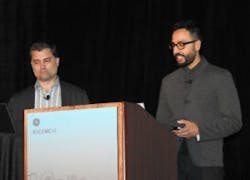“What is the point of data if you cannot visualize it?” GE Digital’s Ranbir Saini (right) and Joe Gerstl demonstrated the ease with which the company’s cloud-based tools could be used to create persona-specific dashboards for effectively managing operations and asset performance.
"I want you to walk out of here with your head spinning from all of these solutions to problems,” began GE Digital’s Steve Vakulskas. The global vice president of solution architecture was on stage to showcase the company’s latest technologies at the 2019 GE Digital User Conference in Austin. He beamed like a kid on Christmas as his colleagues described and demonstrated new and newly enhanced software offerings.
“It’s not about the technology,” Vakulskas insisted. “It’s not about the software. It’s about what it is able to do. It’s about the business processes. These solutions are meant to go across verticals. It’s about unlocking new opportunities.”
In short, these tools turn data into dollars, in Vakulskas’ words. “Data is like another raw material, in that if you process it, data can produce some incredible value for you and your end customers.”
Use Case 1
“What is the point of data if you cannot visualize it?” asked Ranbir Saini, GE Digital senior director of automation software, as he demonstrated how to insert a note in the company’s Operations Hub tool to alert operations of a performance anomaly. Referencing dashboards he projected on a screen, he showed how data comparisons could be easily created and shared, enabling operators to make informed, timely decisions about machine performance. “We’re super excited to get these tools in your hands,” he said.
Sharing the stage was Joe Gerstl, GE Digital director of product management for manufacturing software, who demonstrated the capability of the company’s Manufacturing Data Cloud to develop dashboards based on user personas and simply create a comparison chart of, say, plant performance across European facilities. “The operator can build this himself,” Gerstl stressed. “He doesn’t have to rely on an OT person to come in.”
The duo explored how these tools can benchmark downtime for machines throughout a system, factoring in individual operator performance to glean detailed patterns that inform applications to correct inefficient activities.
Summarized Vakulskas, “No matter what your role is, these tools apply to you. They provide a comprehensive view of data-based recommendations specifically for you. Your role. But it also fits together with the larger enterprise.”
Use Case 2
Next, Kevin Faulkner, GE Digital product marketing director, demonstrated the partnering of the Predix Edge and Predix Essentials tools to drive innovative Industrial IoT outcomes. The Edge tool delivers standard, container-based analytics, while the Essentials tool provides digital twin analytics and content via asset and operations performance management tools (Predix APM and Predix OPM). The intent, as Faulkner described, is to deploy machine-learning analytics where it matters most.
“We determined that these functions are at the core of any IoT use case. They are the basis of any customer application they would build. So we pulled them out as Predix Essentials,” Faulkner explained. The result is the ability to extend reach to the cloud, connect all data and apply analytics throughout the full process. “And this enables a seamless upgrade to APM and OPM when that time arrives,” he added.
Faulkner is most excited about the breadth of data that can be accessed, and the insights—the “investigations” as he labels them—that can be performed in asset and operations performance. “You can look at manufacturing execution system (MES) data in and of itself,” he said. “Or you can combine that with other data. It affords you a catbird seat to look across your plant or your full enterprise and do full root-cause analysis. Predix Essentials is your foundation for the IoT. The sky is the limit.”
Use Case 3
Vakulskas described the next use case thusly: “What fires me up about this is that it’s cool. We’re talking about asset strategy.”
With the knowledge that 80-90% of industrial failures are not time-based, the need to better predict performance is critical. That was at the heart of this presentation, in which GE Digital Senior Product Managers Steve Deskevich and Dan Parker performed a role-playing exercise to display new capabilities within their APM tools. Parker conducted a “live” phone call with a plant manager, during which they could both monitor real-time data, to demonstrate the responsiveness and ease with which GE Digital’s APM solutions can resolve—or head off—machine failures.
“For as long as we’ve been in this industry, we still get surprised,” said Deskevich. “Unfortunately those surprises are sometimes catastrophic. So how do we use technologies that are more predictive? We must leverage predictive data to take action.”
Use Case 4
Lastly, GE Digital OPM Product Manager Cobus Van Heerden took the stage to address the role of operations performance management in unlocking opportunities.
Van Heerden detailed a day in the life of a process engineer at a mining enterprise in which one plant is falling behind the production plan. He explained how OPM can deliver on the promise of continuous process improvement with a template of supply chain operations planning, monitoring for early detection of deviations from optimal performance, immediate alerts in those situations that prompt analysis of KPI deviations, then the development of improvement actions, ideally to be automated.
“This OPM information enables consistent recommendations,” he explained. “Running your facility is one thing. But how are you running it?”
That question “how” permeated the showcase. How are we currently operating? How can we improve? How do we take advantage of these new capabilities?
The host was all ears. “GE Digital is very interested in your feedback. Your use cases,” Vakulskas said while wrapping up the showcase for the conference room full of customers. “What you’re doing is what we’re here to help you do.”





